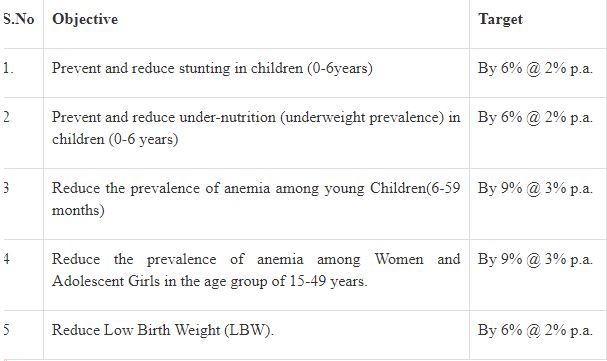National Council on India's Nutrition Challenges
- The first meeting of the National Council on India's Nutrition Challenges was held recently in New Delhi.
- The Council was set up under POSHAN Abhiyaan which is the apex body to formulate overall policies, guide and monitor all nutrition based schemes.
- The mandate of the Council is:
- To provide policy directions to address India’s Nutrition Challenges through coordinated inter-sectoral action
- To coordinate and review convergence among ministries
- To review programmes for nutrition on a quarterly basis
- The Council will submit its report to the Prime Minister every 6 months.
- The annual targets set under POSHAN Abhiyaan beginning 2017-18 are as below.

National Clean Air Program (NCAP)
- The Ministry of Environment, Forest and Climate Change (MoEFCC) released a concept note on the National Clean Air Programme (NCAP) recently.
- The NCAP aspires to overcome the deficits of the ongoing government initiatives targeted towards air pollution control.
- The NCAP was conceived as a detailed strategy to ensure that cities across the country meet specified air quality norms.
- It lays down a comprehensive strategy framework for enhanced management of air quality.
- It also, for the first time, plans to set up pollution-monitoring stations in rural areas.
- It envisions setting up 1,000 manual air-quality-monitoring stations and automatic stations.
- The document highlights lack of indigenous studies establishing the correlation between exposure to air pollution and human health.
- A high-level apex committee and working group has, therefore, been constituted under the Indian Council of Medical Research and the MoEFCC to overcome this deficit.
Star rating of Garbage-Free Cities
- The 1st regional workshop on star rating of garbage- free cities was inaugurated recently.
- It was organized by the Ministry of Housing and Urban Affairs (MoHUA) in collaboration with the New Delhi Municipal Council (NDMC)
- Along with the annual Swachh Survekshan activity, the star rating of garbage free cities will create a healthy competition among the cities to achieve the goals of cleanliness and 100% solid waste management.
- The 7-star rating is innovatively designed on a SMART (Single metric, Measurable, Achievable, Rigorous verification and Targeted towards outcomes) approach.
- It is the first-of-its kind rating tool for assessing cleanliness of cities and towns in India.
- The system, based on 12 parameters, builds on the spirit of healthy competition among cities and the aspirations of cities to progress towards higher standards of “Swachhata” and its sustainability.
- Strengths of star rating protocol -
- Outcome-based tool rather than process based
- Designed to enable cities to gradually evolve into a model (7-star) city
- At the 7-star level, components of 3R (Reduce, Reuse, Recycle) are incorporated.
Hope spots
- In 2013 Andaman and Nicobar Islands and Lakshadweep islands were named as the "hope spots".
- This recognition was given by the International Union for Conservation of Nature (IUCN) and Mission Blue, an organization involved in the study of oceans.
- A Hope Spot is any special place that is critical to the health of the ocean—Earth‘s blue heart.
- It is an area of an ocean that needs special protection because of its wildlife and significant underwater habitats.
- The two groups of islands are the first places in India to have been added in the list of global hope spots.
Advanced Landing Grounds (ALG)
- Fighters, helicopters and transport assets have been deployed at the Advanced Landing Grounds (ALG) as part of the ongoing IAF exercise ‘Gaganshakti-2018'.
- ALGs are short prepared or unprepared airstrips close to the borders in the valleys, which have limited rail or road connectivity due to challenging terrain.
- ALGs located strategically offer an opportunity for swift mobility of troops and equipment close to our Northern and North Eastern borders.
- The challenges faced by pilots in landing at these ALGs are unpredictable weather, undulating terrain, narrow corridor of maneuvering and short runway lengths.
- A large number of ALGs have been operationalized and are being utilized for conducting Inter Valley Troop Transfers (IVTT), Special Heliborne Operations, Air Landed operations and Special Operations.
Groundswell Report
- World Bank released the Groundswell: Preparing for Internal Climate Migration report recently.
- It examines the impacts of internal or in-country migration due to slow onset climate change events.
- Sub-Saharan Africa, South Asia and Latin America could see more than 140 million people move within their countries’ borders by 2050 due to climate change impact.
- The report is the first to look at such possible population distributions within countries.
- It estimates that up to 86 million people could be displaced in Sub-Saharan Africa, 40 million in South Asia, and 17 million in Latin America.
- These regions are the major climate “hot spots” and account for 55% of the developing world’s population.
- The shift will likely involve the poorest people from the poorest countries moving in large numbers from rural regions to increasingly overburdened urban areas.
- The report says that without prior planning, such dramatic swells of migration could lead to major disruption and instability.
- The World Bank urged cities to prepare infrastructure, social services and employment opportunities ahead of the predicted influx.

Source: PIB, The Hindu, Business Standard
